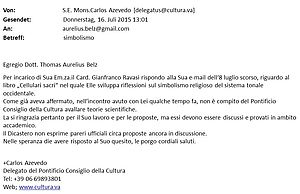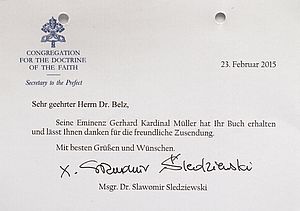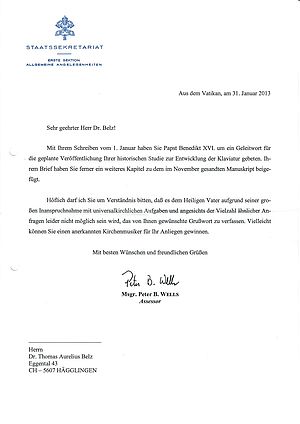B22 On the index of society
"We have a Greek sound system! Nobody is allowed to bring in theological content!" These were the words by an experienced music educator to the author at the moment when his musical worldview threatened to collapse.
However, it is true that we have a Roman Catholic sound system with Greek roots and numerous symbolic references to the Holy Scripture. The interested reader finds in the presentations and in the blog of this page more about the background.
However, this article is not about the discussion of the subject of research, but about the phenomenon of denial of scientific knowledge on a broad front, only for the reason that it is about the rediscovery of theological contents, which in the music of the West of the 3rd century until the time of Johann Sebastian Bach played an essential role.
Today, nobody would be interested in retrospectively to interpret something in the sound system, rather it is about an unbiased consideration of the cultural-historical contexts that were once called Catholic, in the sense of the ancient Greek καθολικός, all-embracing or holistic.
It would have been necessary to realise that although we speak of a Greek sound system, we (in Germany) nevertheless use Latin expressions for the intervals such as: Prim, Sekund and Terz. Just the comparison of the Greek terms with the Latin expressions would have drawn attention to significant differences, as presented in the presentation XI, "On the Origin of the Western Sound System". As we learn from a contemporary source, a "translation" did not come until the third century, because until then, the Romans used the Greek terms throughout.
The early Christians did not simply take over the cultural property of their tormentors, whose polytheism they detested. Especially in the depraved and extravagant rites of the Romans they saw the epitome of the sinful, forbidding of course the participation and subjected the sound system of a sanctification, by making numerous references to the Scriptures. We have to think of this as a process that took a certain time, because such a networked adaptation to the monotheistic perspective can not be expected from one day to another. In general, the Catholic doctrine could only take shape through several Council decisions. For a long time, about the doctrine of Trinity and the creed was discussed. At the same time, the book of books itself was still in a phase of development, and it can hardly be any different with regard to numerical values and their symbolic relevance.Today, we speek about 8 blessings and 7 gifts of the Holy Spirit, for 13 blessings are mentioned in the Bible, and of only 6 gifts of the Holy Spirit the Hebrew original text reports.There is also a dilemma with regard to the 5 wounds, because either the crown of thorns has to be disregarded, or the two wounds on the feet are counted as one, because a single nail was driven through both feet. Five-wound crosses and five-wound rosaries show both variants. With mathematical precision in mind one does not have to approach Christian symbolism. The procedure continues in music, where halves are counted as a whole, 5 whole and 2 half result in 8 and subsequently still provisional figures such as a "little two" (minor second) and "big three" (major third) were inserted.
In this way, the observations in the starry sky (harmony of the spheres) and the monochord according to the then state of knowledge were brought into line with the doctrine of the faith, in order to be able to draw attention to the creation plan of God by showing analogies.Thus, the contemporaries explained the nature of the world. Today, one would speak of a corporate identity of the world manufacturer. For example the idea of the church father Irenaeus (* ca.135 - † ca.200) is known, which explaines the presence of the four Gospels with the four world regions and the four main directions of the wind. The four-part Gospel thus symbolizes the whole world. Whether, by implication, these reasons led to the inclusion of only four Gospels in the Bible, rejecting the others, can not be discussed here. The only certainty is that the decision was made from the perspective of the time and not from today.
The same symbolic references have found the path to educational material, were preached by pulpits and showed thousands of times in arts, and therefore are still legible in them today. They form the small multiplication table of art history, if you will. In addition, the people interpreted in their own way: Currently everyone is familiar with Friday, the 13th with reference to Good Friday and the 13 participants in the Last Supper. From the combination of these two, for Christians: traumatic events, betrayal and death, the day of misfortune has emerged in the vernacular. Therefore, this number is missing on the doors of the hotel rooms so as not to scare the guest on arrival with a bad omen.
Symbolism follows its own psychological rules - generates evil foreshores, triggers memories of visualized cruelty (martyrs, crucifixion) - especially effective in a time when illness and death were very present and public executions took place - evoking hope and longing for bliss (see Blog B 12: "Symbols, Mirrors of Man"). Symbols summarize complex contexts in the form of an abbreviation and are found in liturgical acts in a special condensation. The reason for this is obvious, because where the sensory is missing, because we are dealing with the spiritual, only parables - including the meaningful symbols with their analogy - are able to describe the world of imagination.Symbols contribute to a networking of thinking and feeling. As presented in Presentation VIII "Introduction to christian numerical symbolism", each number from 1-15 was sometimes even interpreted several times - but certainly at the expense of rationality, because numbers are abstract and here assigned to concrete facts, manifestations or ideas. Basically, nothing else took place in this way than an instrumentalization of mathematics. Numbers provide pseudo-proofs, as Cardinal Nicholas of Kues (* 1401- † 1464) put it much later: "If we can not approach the divine in any other way than by symbols, we will most appropriate use mathematical symbols, because these possess indestructible certainty "-an illogical proposition, since it excludes the possibility of a false calculation and is based only on the suggestive combination of numbers and precision. It is hard to imagine that the learned cardinal would not have been aware of it - and if not, he reveals his manipulative calculus. Nevertheless, with this formulation, he bows to a discipline that can prove its truth-knowledge and envies the attainment of "indestructible certainty," which he can not claim from faith - otherwhise it wound't be faith. With the violent suppression of free, logical and critical thinking set in what should be called in retrospect as eclipse of the Middle Ages. For more details in Blog B 18: "The Christian-medieval world view and its methodological shortcomings".
From the 5th century we hear of a patron saint of music, St. Caecilie, whose martyrdom around the year 230 brought a strong veneration.

Stefano Maderno, Santa Caecilia, Trastevere, Rome
Her bones are in Santa Caecilia in Trastevere in Rome, a smaller part in the Cathedral Sainte Caecile in Albi, the largest brick building in the world in the Tarn department in France. Cardinal Jean Jouffroy had specially brought a part of their relics there, making Albi a well-known place of pilgrimage. He himself was buried at his request in 1473 under the reliquary.

Sainte Cécile, Albi, France
Of the marble sculpture created around 1600 by Stefano Maderno, a sufficiently similar copy was made in Albi. In addition, small-format casts arrived as devotional items to the pilgrims.

Santa Caecilia, small bronze as devotional artefact
It is astonishing that Saint Caecilia is now recognized in relevant dictionaries as the patron saint of sacred music - that is, that she is granted only the responsibility for a section - but not the sovereignty over the music as a whole. There is no doubt that such a downgrading as well as the rejection of symbolic references has to be seen in the context of Enlightenment, with the introduction of the Revolution Calendar, the 10-day week and the 10-hour day, just to pick out a few examples. The division of the sciences into different disciplines did the rest, in order to obscure the Catholic worldview, which intended to make visible the wholeness of creation. Previously, the Septem Artes Liberales – consisting of Trivium and Quadrivium - were based on another, namely spiritual, interest - not in a scientific one.
All this explains show how it could come to focusing on Greece as the place of origin of Western music, which in principle was quite right. But by doing so we also observe a countermovement, for in the same way as the early Christians were able to differentiate themselves from the Greek and Roman ratio by means of symbolism, the turn to the Greeks is now an escape from symbolism. A remarkable turnaround after 1500 years of church rule. The impartiality of cultural-historical research suffers until today under the impact of the Enlightenment liberation blow. One simply does not want to take note of the theological content what can be easily achieved only by insistence on a separation of the disciplines. However, this is not scientifically correct.
An important role in the history of music takes Guido of Arezzo (* 992 - † 1050). Because he was a Benedictine monk, it would have been necessary to give reason for thinking about the perspective from which he considered the historical events, besides, his own statements are sufficiently clear. So he refers for example clear on the congruence between the diatonic tone sequence and the biblical days of the week, as shown in the presentation XII with the title: "The development of the keyboard". Likewise he writes: "So there are eight keys as there are eight kinds of bliss." More about this in Presentation VII: "How the Octave got its name." Due to the pronounced specialization, there is a lack of basic knowledge to understand the intimately intertwined relations to the neighboring disciplines.
But let us return to the problem of rejection. Martyrs can only exist because different thinking can not be tolerated by certain interest groups who want to defend their own world view. Cruelty serves as a means of deterrence. Other variants are the censorship or the index. Then comes ignorance - the simple refusal to take note of something. In the effort not to discuss a matter of fact and thus dismiss it as unworthy, the fear is recognizable that it could change the previous doctrine - usually in conjunction with established power structures. If you do not address a sensitive topic at all, everything stays as it was and the dissenting person is silenced by rejection.
This also explains the behavior of the Pontificio Consiglio della Cultura towards the author, because the publication promise of the Libreria Editrice Vaticana was withdrawn without substantive comments, lecture and discussion offers repeated and abruptly rejected. It would not be the task of the Pontificio Consiglio della Cultura to endorse scientific theories.
To improve readability, please click on the documents
Thus, there could be no doubt concerning the location of competence. In this way, the Vatican's supreme ruling authority concernin culture overruled the recommendation of the Pontificio Istituto di Musica Sacra, and the favorable words of the retired Benedict XVI were no longer relevant (see Blog B2 and B6). Nor did it help that he quoted from the liturgical constitution of the Second Vatican Council: "The treasure of sacred music must be preserved and promoted with the utmost care." Similarly, the commitment of Cardinal Gerhard Ludwig Müller led to no result and all attempts to penetrate to Pope Francis, remained unsuccessful, especially because the responsibility for cultural assets clearly lies with the Pontificio Consiglio della Cultura. It is completely ruled out that one's own cultural heritage has not been recognized - and the submitted evidence has not been taken note of.
Although the author was concerned bringing back to the intellectual owner a lost cultural heritage, combined with the expression of highest appreciation for the interdenominational nature of the found object, it would be conceivable that the study revealed too much manipulative influence, for the music was instrumentalized in ideological intentions and people mentally influenced, even moved to tears, that neither about an autonomy of arts nor a free will decision regarding faith can seriously be talked about - from a too early date of baptism for a personal statement quite apart - because beyond that it's about church tax and thus, power, influence a lot of money. May the reader form an opinion as to whether demonstrative closeness to science at Catholic universities is not hypocritical in the face of such behavior, for the sting in the flesh is the lack of proof of God. From the shown togetherness - as seen in the example of the numbers - emanates a suggestive message. However, science will resolutely resist any attempt at instrumentalization, otherwise it will lose its identity. The lack of a return to the ethical values is also a very serious and much discussed topic within the church.
On the one hand, such processes describe a brake on the development of society, which has a high price to pay, because, as will be shown, it is about no less than the civilizing progress, on the other hand the pressure on scientists raises and hence the need to struggle for truth. Church history has many examples, even the works of the Swiss music theorist Henricus Glareanus (*1488- †1563) came to the index. The suppression of a new knowledge serves only the preservation of power and not the civilizational development.
The church has frighteningly often disregarded its own values and ignored the fifth commandment, even calling for crusades. Therefore, it is not surprising that enlighteners intended to keep the music free from their influence, ignored the symbolism and accepted the responsibility of Caecilia only for the sacred area. The idea of autonomy of the arts played a major role in this process. Nevertheless, the symbolic content of the diatonic scale is a very special one. Reference should be made to Presentation IX entitled "The Theological Foundations of Western Harmonics". No bliss without wisdom and no wisdom without love of enemies ... that is a very high demand on humanity. The ethical values summarized under the title "7 Gifts of the Holy Spirit" contain the recipe for intercultural understanding and combine harmony with no lesser goal than world peace. This is the theological background for the motto to be found in many places: MUSICA DONUM DEI and the reason for the relevance of the organ in the sacred space as a counterpart to the altar, from which it has taken over many design elements.
The intangible music is meant to recall Jacob's dream, for in Genesis 28:12 it says, "He had a dream in which he saw a stairway resting on the earth, with its top reaching to heaven, and the angels of God were ascending and descending on it." and later in verses 16 and 17, "And he was afraid and said, “How awesome is this place! This is none other than the house of God, and this is the gate of heaven" The analogy is reinforced both by the notation of scale and by the notion of octave, which brings the eight bliss into agreement with consonance.
Music defines the sacral space in this way, so the sound openings of the instruments were provided with church rose windows for centuries to express their sacredness. Just as in the cathedrals the light penetrates through them, which is connected with Christ, as he said of himself: "I am the light of the world" (Jn 18:12), so through the same sacral element music comes as God's gift to the people.That is why we see the exterior site of the roses on instruments. In both cases we are dealing with intangible manifestations - light and sound - and their theological interpretation.
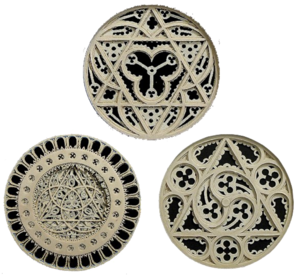
Various soundboard rosettes with religious references
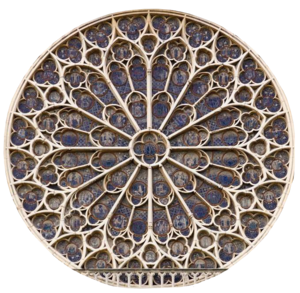
For comparison: window rose from the outside, Notre Dame, Paris
In the instruments corpus a kind of tabernacle was seen. Therefore, we find among the soundhole ornaments also numerous representations of trinity. An important example by Arnaut de Zwolle from around 1440 is presented in the presentation X entitled "Sacral phones". In addition, there is no shortage of written evidence. For example, Martin Luther formulated:
"Who chooses the music,
has won a heavenly work;
because their first origin is
taken from heaven itself,
because the dear angels
are musicians themselves. "
Ignoring such a wealth of materials is incredible. Since this can be observed even in scientific circles, an article by the author was published with the title: "Polydisziplinäre Betrachtungen zur Symbolik des abendländischen Tonsystems. Über die akademische Missachtung europäischen Kulturerbes." (In: Rivista Internazionale di Musica Sacra, 36, 2015, 49-79.)
The dismissive attitude up to stubbornness is thematized in the artistically high-level embodiment of the spinet of Giulia da Varano, Duchess of Urbino, from 1540 in the Metropolitan Museum, New York. The special reference to the prophet Isaiah is associated with a warning of the fatal consequences - especially of sin and evil. Explicitly, therefore, it says on the front board of the instrument "... non mi toccar, si tu non ha del buono".
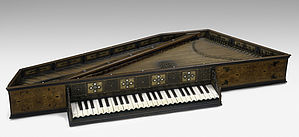
Spinet of Giulia da Varano, Metropolitan Museum, New York
More on this in the video presentation XVII
In effort to find out which other interest groups might reject cultural studies, we encounter the phenomenon of the spirit of times. Due to the communicative networking, the reader has sufficient sources of information and clues available, which therefore do not have to be listed separately. It is worth considering the underlying characteristics of man concerning self-critical consideration. Also, the willingness to change - especially when it comes to substantial innovations - is not for everyone. In addition, differentiation from other ethnicities, cultures and faith communities as well as the preservation of wealth, competence and responsibility play an important role. Psychologists could write long essays about it.
In this connection, reference should be made to the decision of the Zurich Education Directorate, which is presented in Blog Post B20 and prevents the inclusion of the facts in the cantonal curriculum.
Publishers and the media analyze the spirit of times very closely, because they live on ratings and sales. Therefore, they are aware of which offers are of interest and which are not and tend to be mirrors of society. With the mission to compensate educational deficits or even to enter new scientific territory, they are overstrained. The collective ignorance of numerous publishers and the media was nevertheless astonishing and led to Blog B 21 and 23.
For the researcher it is sufficient to state that there is a significant cultural-historical find - a part of the late antique Catholic worldview. Looking at the distribution of the sound system and the keyboard, we can even speak of a World Heritage. Being aware of this forms the basis for a deeper understanding of cultural and especially music-historical contexts. Here is an example:
As Christoph Bossert noted in his extensive analysis of works, Johann Sebastian Bach saw in music - based on Psalm 118 verse 22 - the stone that the builders rejected and became the cornerstone. In the art of the fugue Bach made his personal creed, both in the symbolism of his music - especially with the B-A-C-H motif he refers to the Gospel of Luke 10, 20 where it says: "Rejoice that your names are written in heaven" and with the sudden termination of the fugue he stages his own death - as well as in the symbolism of the accompanying drawings, the existence of which the author only recently drew attention to. At the same time as the end of Contrapunktus 5, Bach introduces a passion flower with 14 petals, but the number does not correspond to the botanical example, but rather to the numerical translation of his name (A = 1, B = 2, C = 3, H = 8, 1 + 2 + 3 + 8 = 14). In the context described, it is obvious that the 4 concentric rings do not refer to the 4 evangelist but to the 4 letters of his name.
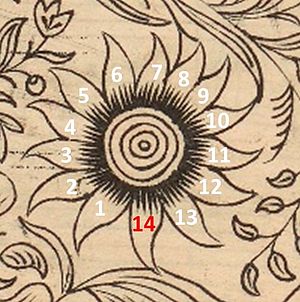
J.S. Bach, The Art of the Fugue, Passiflora from Contrapunctus 5
Then, after the end of the play, he symbolically depicts, according to its - and in view of the Passiflora connected with his name also according his own - death, the view of a meadow in reference to Psalm 23: 2: "He grazes me on a green meadow and leads me to fresh water."
It is almost typical of his compositional approach to say the same thing in two ways. Here, the musical-semantic is reflected in the visual-numeric and resembles the repetition of the joint theme B-A-C-H in illustrative registration. How consciously he made the transition to the visual composition mode, shows blog post C3: "The credo of Johann Sebastian Bach in image and sound" and the presentation XV entitled "Bach flowers".
In an analogous way, as J.S.Bach tried in his time to defend the "majesty of ancient music" against the spirit of times of the enlightenment and for this purpose joined the Corresponding Society of Musical Sciences, the International Society for music-theological Bach-research has to defend its scientific work against a spirit of times that seems to lose the love of truth. In due course, one will find an apt term for this phenomenon. Word creations such as fake news and alternative facts describe an irresponsible misuse of the mind. There is a lack of self-critical reflection, because strategic thinking causes immense damage throughout the world and reduces the synergy competence - which the harmonics teach in an exemplary way - in an alarming mass. In post-war times, such content is much better understood than in periods of prosperity. Therefore, the Protestant peace churches that emerged after the Thirty Years' War include the organ in the altar structure in a particular manner. The intimate bond between theology and music is an important part of Western cultural history.
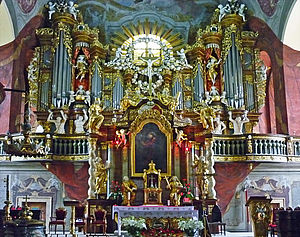
Grace Church to the Holy Cross in Jelenia Góra
Today we face a grotesque situation. At the one hand, it is understandable that musicians accept no influence in their work by a religious community, but on the other, history plays an important role. This applies not only to the analysis of the vibrating string by the Greeks but also to the redefinition of the content by the Catholic Church, which enriched the sound material with new interpretations - a process that should continue unabated after the Reformation in Protestantism.
In many places, the music is used for the purpose of understanding between nations and pursues exactly the same concern that symbolically was intended: world peace! - achievable through the preservation of one's own conviction and the appreciative approach to one's fellow human beings. Thus, the different faith communities and cultures are invited to try a synergetic new beginning against the background of their warlike history. Should this ever succeed, the result will essentially be in the sense of the ancient Greek καθολικός, all-embracing or holistic. It is all the more astonishing that now just this faith community, which bears this name, rejects its own cultural heritage as a scientific theory.
Without any doubt, the matter would have taken a completely different course if Benedict XVI had found the time in January 2013 - his resignation on February 11, 2013 was imminent - to write the preface to the study.
To improve readability, please click on the document
© 2019 Aurelius Belz


